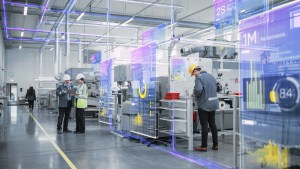In a previous blog post, we discussed the basics of the Potential-Failure (P-F) curve, which refers to the interval between the detection of a potential failure and occurrence of a functional failure. In this post we’ll discuss the cost-benefit tradeoffs of various maintenance approaches.

In general, the goal is to maximize the P-F interval, which is the time between the first symptoms of impending failure and the functional failure taking place. In other words, you want to become aware of an impending failure as soon as possible to allow more time for action. This, however, must be balanced with the cost of the methods of prevention, inspection, and detection.
There is a trade-off between the cost of systems to detect and predict the failures and how soon you might detect the condition. Generally, the earlier the detection/prediction, the more expensive it is. However, the longer it takes to detect an impending failure (i.e. the more the asset’s condition degrades), the more expensive it is to repair it. Every asset will have a unique trade-off between the cost of failure prevention (detection/prediction) and the cost of failure. This means some assets probably call for earlier detection methods that come with higher prevention costs like condition monitoring and analytics systems due to the high cost to repair (see the Prevention-1 and Repair-1 curves in the Cost-Failure/Time chart). And some assets may be better suited for more cost-efficient but delayed detection or even a “run-to-failure” model due to lower cost to repair (the Prevention-2 and Repair-2 curves in the Cost-Failure/Time chart).
Every asset will have a unique trade-off between the cost of failure prevention (detection/prediction) and the cost of failure. This means some assets probably call for earlier detection methods that come with higher prevention costs like condition monitoring and analytics systems due to the high cost to repair (see the Prevention-1 and Repair-1 curves in the Cost-Failure/Time chart). And some assets may be better suited for more cost-efficient but delayed detection or even a “run-to-failure” model due to lower cost to repair (the Prevention-2 and Repair-2 curves in the Cost-Failure/Time chart).
 There are four basic Maintenance approaches:
There are four basic Maintenance approaches:
:
Reactive
The Reactive approach has low or even no cost to implement but can result in a high repair/failure cost because no action is taken until the asset has reached a fault state. This approach might be appropriate when the cost of monitoring systems is very high compared to the cost of repairing or replacing the asset. As a general guideline, the Reactive approach is not a good strategy for any critical and/or high value assets due to their high cost of a failure.
Reactive approaches:
-
-
- Offer no visibility
- Fix only if it breaks – low overall equipment effectiveness (OEE)
- High downtime
- Uncertainty of failures
Preventative
The Preventative approach (maintenance at time-based intervals) may be appropriate when failures are age related and maintenance can be performed at regular intervals before anticipated failures occur. Two drawbacks to this approach are: 1) the cost and time of preventative maintenance can be high; and 2) studies show that only 18% of failures are age related (source: ARC Advisory Group). 82% of failures are “random” due to improper design/installation, operator error, quality issues, machine overuse, etc. This means that taking the Preventative approach may be spending time and money on unnecessary work, and it may not prevent expensive failures in critical or high value assets.
Preventative approaches:
-
-
- Scheduled tune ups
- Higher equipment longevity
- Reduced downtime compared to reactive mode
Condition-Based
The Condition-Based approach attempts to address failures regardless of whether they are age-based or random. Assets are monitored for one or more potential failure indicators, such as vibration, temperature, current/voltage, pressure, etc. The data is often sent to a PLC, local HMI, special processor, or the cloud through an edge gateway. Predefined limits are set and alerts (alarm, operator message, maintenance/repair) are only sent when a limit is reached. This approach avoids unnecessary maintenance and can give warning before a failure occurs. Condition-based monitoring can be very cost-effective, though very sophisticated solutions can be expensive. It is a good solution when the cost of failure is medium or high and known indicators provide a reliable warning of impending failure.
Condition-based approaches:
-
-
- Based on condition (PdM)
- Enables predictive maintenance
- Improves OEE, equipment longevity
- Drastically reduces unplanned downtime
Predictive Analytics
Predictive Analytics is the most sophisticated approach and attempts to learn from machine performance to predict failures. It utilizes data gathered through Condition Monitoring, and then applies analysis or AI/Machine Learning to uncover patterns to predict failures before they occur. The hardware and software to implement Predictive Analytics can be expensive, and this method is best for high-value/critical assets and expensive potential failures.
Predictive Analytics approaches:
-
-
- Based on patterns – stored information
- Based on machine learning
- Improves OEE, equipment longevity
- Avoids downtime
Each user will need to evaluate the unique attributes of their assets and decide on the best approach and trade-offs of the cost of prevention (detection of potential failure) against the cost of repair/failure. In general, a Reactive approach is only best when the cost of failure is very low. Preventative maintenance may be appropriate when failures are clearly age-related. And advanced approaches such as Condition Based monitoring and Predictive Analytics are best when the cost of repair or failure is high.
Also note that technology providers are continually improving condition monitoring and predictive solutions. By lowering condition monitoring system costs and making them easier to set up and use, users can cost-effectively move from Reactive or Preventative approaches to Condition-Based or Predictive approaches.
Like this:
Like Loading...












